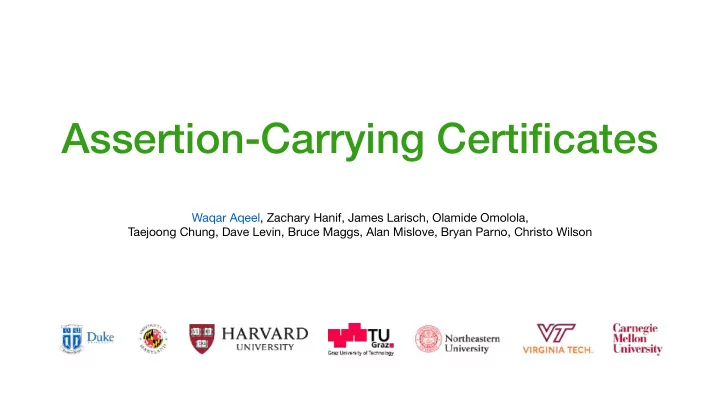

Assertion-Carrying Certificates Waqar Aqeel, Zachary Hanif, James Larisch, Olamide Omolola, Taejoong Chung, Dave Levin, Bruce Maggs, Alan Mislove, Bryan Parno, Christo Wilson
The Public Key Infrastructure is how users know with whom they are communicating online
Certificates encapsulate identity (who hosts are) and capability (what they can do)
Certificates encapsulate identity (who hosts are) and capability (what they can do) Traditional PKI roles Subject Name Who the cert is about Issuer Name Who vetted the subject’s identity Expiration Dates When is the certificate no longer valid Public key and signature Attestation of cryptographic identity
The PKI has had to evolve to meet new threats, deployments, and opportunities Traditional PKI roles New additions to the PKI Subject Name Key Usage Who the cert is about Certificate signing, authentication Issuer Name Subject Alternate Names Who vetted the subject’s identity Support deployments in CDNs Expiration Dates When is the certificate no longer valid Public key and signature Attestation of cryptographic identity
The PKI has had to evolve to meet new threats, deployments, and opportunities Traditional PKI roles New additions to the PKI Subject Name Key Usage Who the cert is about Certificate signing, authentication Issuer Name Subject Alternate Names Who vetted the subject’s identity Support deployments in CDNs Expiration Dates Revocation Information When is the certificate no longer valid New ways to deliver revocations Public key and signature Certificate Transparency Attestation of cryptographic identity Allows greater insight into CA (mis)behavior
The PKI must continue to evolve but adding new features is slow and laborious Traditional PKI roles New additions to the PKI Future additions Subject Name Key Usage Naming constraints Who the cert is about Certificate signing, authentication Let non-CAs issue their own certs, limited to domains they control Issuer Name Subject Alternate Names Signed exchanges Who vetted the subject’s identity Support deployments in CDNs Sign-over the hosting of some resources to a third party Expiration Dates Revocation Information Multi-rooted certificates When is the certificate no longer valid New ways to deliver revocations Minimize the reliance on a small set of trusted certificate authorities Public key and signature Certificate Transparency Attestation of cryptographic identity Allows greater insight into CA (mis)behavior And many more!
• More evolvable Is there one extension we could add • More customizable to new deployments that would make the PKI: • Easier to formally verify Insight: A certificate is a set of constraints Name Validity period Allowed usages Why not encode constraints in small programs in the certificate?
Assertion-Carrying Certificates (ACCs) Rules
Assertion-Carrying Certificates (ACCs) Add small programs that must be run as part of the certificate’s validation Rules Assertions
Assertion-Carrying Certificates (ACCs) Add small programs that must be run as part of the certificate’s validation Rules Define new capabilities What it means to be name-constrained Assertions Enforce them as constraints All certificates following this one must be name-constrained
Assertion-Carrying Certificates (ACCs) Language goals All constraints across all certs in the chain must hold Certs can never relax constraints further up the chain Rules Browsers can add their own constraints, as well The language should be concise and expressive Does not need to be Turing-complete Assertions Should be formally verifiable Must not broaden the attack surface A logic-based programming language is a natural fit
Assertion-Carrying Certificates (ACCs) What is the appropriate constraint language? Prolog Datalog ✅ Non-Turing-complete X ✅ X Declarative X Termination guaranteed ✅ ½ ✅ Amenable to static analysis ✅ Fully expressive ½ We might not need these ✅ Negation ½ Unbounded lists, numbers, strings ✅ X
Assertion-Carrying Certificates (ACCs) Allow for a far more agile PKI Ongoing and Future E ff orts Today’s PKI is slow to evolve Implementing long-desired features ACCs add small programs that must be run as part of the certificate’s validation Naming constraints, signed exchanges, and more Re-implementing various browsers’ validation logic in Prolog/Datalog Chrome, Firefox, mbedTLS — in far fewer lines of code Exploring ways to verify correctness: - Static analysis - Certificate fuzzing - Using the languages’ imputation Is there any certificate that is valid but where constraint X does not hold?
Recommend
More recommend